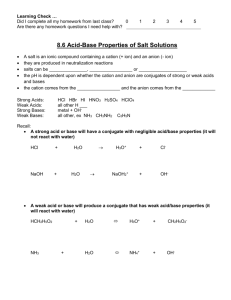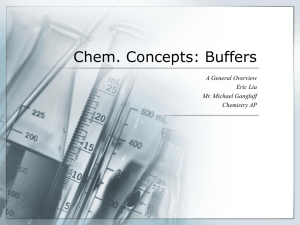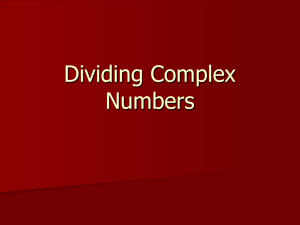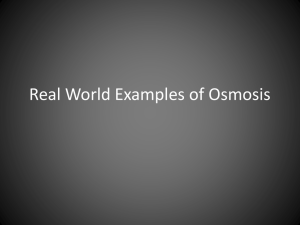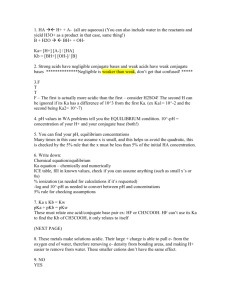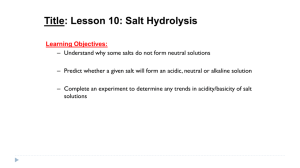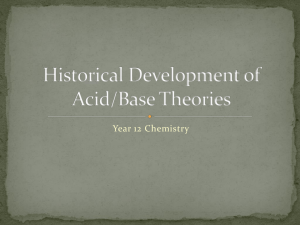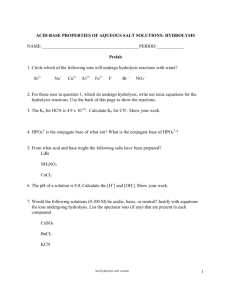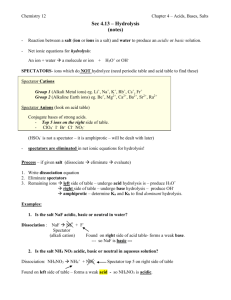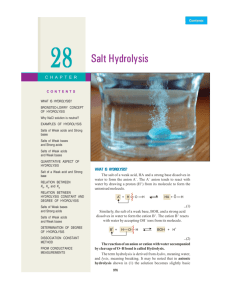Salt Hydrolysis
advertisement
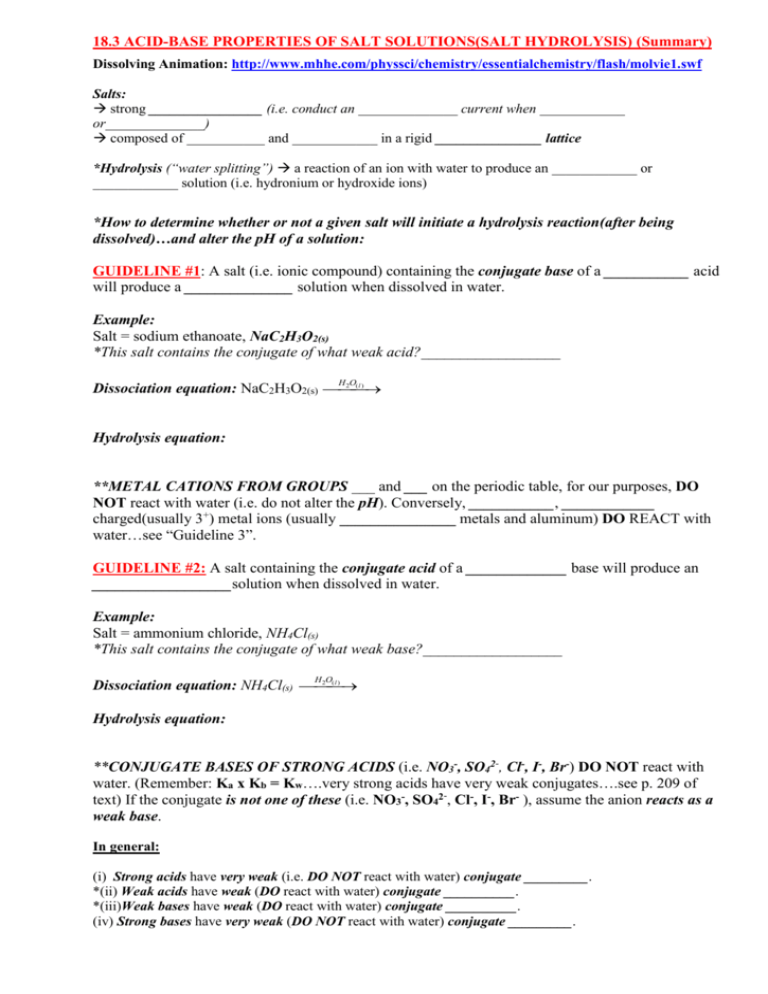
18.3 ACID-BASE PROPERTIES OF SALT SOLUTIONS(SALT HYDROLYSIS) (Summary) Dissolving Animation: http://www.mhhe.com/physsci/chemistry/essentialchemistry/flash/molvie1.swf Salts: strong ________________ (i.e. conduct an ______________ current when ____________ or______________) composed of ___________ and ____________ in a rigid _______________ lattice *Hydrolysis (“water splitting”) a reaction of an ion with water to produce an ____________ or ____________ solution (i.e. hydronium or hydroxide ions) *How to determine whether or not a given salt will initiate a hydrolysis reaction(after being dissolved)…and alter the pH of a solution: GUIDELINE #1: A salt (i.e. ionic compound) containing the conjugate base of a ___________ acid will produce a ______________ solution when dissolved in water. Example: Salt = sodium ethanoate, NaC2H3O2(s) *This salt contains the conjugate of what weak acid?__________________ 2 (l ) Dissociation equation: NaC2H3O2(s) H O Hydrolysis equation: **METAL CATIONS FROM GROUPS ___ and ___ on the periodic table, for our purposes, DO NOT react with water (i.e. do not alter the pH). Conversely, ___________, ____________ charged(usually 3+) metal ions (usually _______________ metals and aluminum) DO REACT with water…see “Guideline 3”. GUIDELINE #2: A salt containing the conjugate acid of a _____________ base will produce an __________________solution when dissolved in water. Example: Salt = ammonium chloride, NH4Cl(s) *This salt contains the conjugate of what weak base?__________________ 2 (l ) Dissociation equation: NH4Cl(s) H O Hydrolysis equation: **CONJUGATE BASES OF STRONG ACIDS (i.e. NO3-, SO42-, Cl-, I-, Br-) DO NOT react with water. (Remember: Ka x Kb = Kw….very strong acids have very weak conjugates….see p. 209 of text) If the conjugate is not one of these (i.e. NO3-, SO42-, Cl-, I-, Br- ), assume the anion reacts as a weak base. In general: (i) Strong acids have very weak (i.e. DO NOT react with water) conjugate _________. *(ii) Weak acids have weak (DO react with water) conjugate __________. *(iii)Weak bases have weak (DO react with water) conjugate __________. (iv) Strong bases have very weak (DO NOT react with water) conjugate _________. GUIDELINE #3: Small, highly charged metal ions (e.g. Al3+(aq), Fe3+(aq), and Sn2+(aq) react with water to produce _________________ solutions. Example: Salt = aluminum nitrate, Al(NO3)3(s) 2 (l ) Dissociation equation: Al(NO3)3(s) H O Hydration (formation of hydrated complex ion): Al3+(aq) + 6H2O(l) Hydrolysis equation: Al(H2O)63+(aq) + H2O(l) Extension: *Hydrolysis of Amphoteric Ions: Example: Baking soda, NaHCO3(s) Dissociation: 2 NaHCO3(s) H O Hydrolysis(2): #1(acid hydrolysis): HCO3-(aq) + H2O(l) Ka = HCO3-(aq) + H2O(l) Kb = and #2(base hydrolysis): *Net Effect Acidic or Basic? Kb _______ Ka, therefore, solution will be ___________ (i.e. pH > 7) *Read 8.3 and answer section questions
![1. Find the pH of 0.1 M HClO4 This is a strong acid, so [H ] = 0.1 M](http://s3.studylib.net/store/data/008121755_1-338138652fc42091377fe33aaddd7c71-300x300.png)
